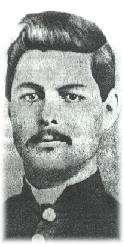Kidder Massacre Site
category : Military History
 On June 1, 1867, Lieutenant Colonel George A. Custer led a campaign from Fort Hays with a regiment of 1,100 men of the 5th Calvary with the intention of engaging the Indians in combat and quelling the hostilities against the wagon trains and small groups of whites. Although Custer could see the Indians' smoke signals by day and flaming arrows by night they refused to attack so large of force.
On June 1, 1867, Lieutenant Colonel George A. Custer led a campaign from Fort Hays with a regiment of 1,100 men of the 5th Calvary with the intention of engaging the Indians in combat and quelling the hostilities against the wagon trains and small groups of whites. Although Custer could see the Indians' smoke signals by day and flaming arrows by night they refused to attack so large of force.Custer moved north to Fort McPherson, and on south to the fork of the Republican, near Benkelman, Nebraska. While there, a supply train bringing him supplies from Fort Wallace was attacked on the Custer trail by Pawnee Killer and 500 Souix warriors. Custer later wrote that his guide. William Comstock, saved the day until reinforcements could arrive.
When Custer did not receive any word from General William T. Sherman, as expected, he moved his men to Fort Sedgwick, near Julesburg, Colorado. There he learned he had missed Lieutenant Lyman S. Kidder and his escort of 10 men and a Souix Indian guide named Red Bead, who had gone to the fork of the Republican and turned south on the trail to Fort Wallace.
Custer was so concerned for the safety of the small group that he left immediately and headed back south. His advance party discovered a dead pony on the trail; the place where they had left the trail with their horses running, and finally the decomposed bodies of Kidder and his whole party. The bodies were in a ravine, near where the Custer trail crossed the Beaver. They were badly mutilated and all had been scalped except the Indian guide. The bodies were discovered the 12th of July and it was believed they had been killed ten days before by a large party of Sioux and Cheyenne.
They were buried in a common grave, but later were reinterred in Fort Wallace, and after the 1880s at Fort Leavenworth, except for the young Lieutenant. Judge Kidder, his father, came to Sherman County in February, 1868, and identified the body by a shirt his mother had made the boy, and took his body back to their home in the Dakotas.
On August 3, 1969, a historical marker and monument commemorating this event was located on the Kuhrt Ranch in the northeast part of the county on the Edson-Bird City road.
Come visit us in Goodland, Kansas
